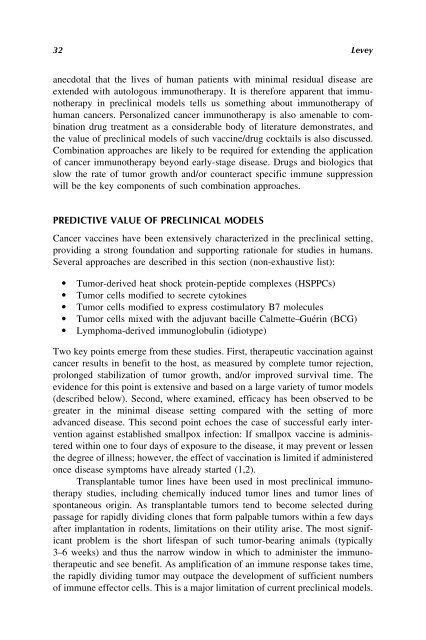Download File - JOHN J. HADDAD, Ph.D.
Download File - JOHN J. HADDAD, Ph.D.
Download File - JOHN J. HADDAD, Ph.D.
You also want an ePaper? Increase the reach of your titles
YUMPU automatically turns print PDFs into web optimized ePapers that Google loves.
32 Levey<br />
anecdotal that the lives of human patients with minimal residual disease are<br />
extended with autologous immunotherapy. It is therefore apparent that immunotherapy<br />
in preclinical models tells us something about immunotherapy of<br />
human cancers. Personalized cancer immunotherapy is also amenable to combination<br />
drug treatment as a considerable body of literature demonstrates, and<br />
the value of preclinical models of such vaccine/drug cocktails is also discussed.<br />
Combination approaches are likely to be required for extending the application<br />
of cancer immunotherapy beyond early-stage disease. Drugs and biologics that<br />
slow the rate of tumor growth and/or counteract specific immune suppression<br />
will be the key components of such combination approaches.<br />
PREDICTIVE VALUE OF PRECLINICAL MODELS<br />
Cancer vaccines have been extensively characterized in the preclinical setting,<br />
providing a strong foundation and supporting rationale for studies in humans.<br />
Several approaches are described in this section (non-exhaustive list):<br />
l Tumor-derived heat shock protein-peptide complexes (HSPPCs)<br />
l Tumor cells modified to secrete cytokines<br />
l Tumor cells modified to express costimulatory B7 molecules<br />
l Tumor cells mixed with the adjuvant bacille Calmette–Guérin (BCG)<br />
l Lymphoma-derived immunoglobulin (idiotype)<br />
Two key points emerge from these studies. First, therapeutic vaccination against<br />
cancer results in benefit to the host, as measured by complete tumor rejection,<br />
prolonged stabilization of tumor growth, and/or improved survival time. The<br />
evidence for this point is extensive and based on a large variety of tumor models<br />
(described below). Second, where examined, efficacy has been observed to be<br />
greater in the minimal disease setting compared with the setting of more<br />
advanced disease. This second point echoes the case of successful early intervention<br />
against established smallpox infection: If smallpox vaccine is administered<br />
within one to four days of exposure to the disease, it may prevent or lessen<br />
the degree of illness; however, the effect of vaccination is limited if administered<br />
once disease symptoms have already started (1,2).<br />
Transplantable tumor lines have been used in most preclinical immunotherapy<br />
studies, including chemically induced tumor lines and tumor lines of<br />
spontaneous origin. As transplantable tumors tend to become selected during<br />
passage for rapidly dividing clones that form palpable tumors within a few days<br />
after implantation in rodents, limitations on their utility arise. The most significant<br />
problem is the short lifespan of such tumor-bearing animals (typically<br />
3–6 weeks) and thus the narrow window in which to administer the immunotherapeutic<br />
and see benefit. As amplification of an immune response takes time,<br />
the rapidly dividing tumor may outpace the development of sufficient numbers<br />
of immune effector cells. This is a major limitation of current preclinical models.

















